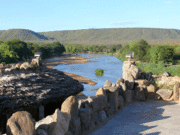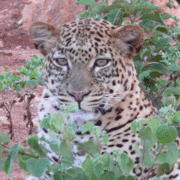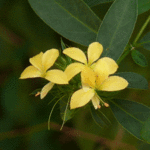River Up, River Down, River Now Chocolate Brown
 Thursday, March 11, 2010 at 11:46AM
Thursday, March 11, 2010 at 11:46AM To put things in perspective, I’m going to take you back to October, during the height of the dry season. In fact, with the rains having failed for 18 months, it might be more apt to say it was a drought.
You’ll remember that the river had dried up completely on 6th September 2009. Because the subterranean flow was still strong, we decided to imitate the elephants and dig a hole in the sand to allow all the other animals to drink. Our pool attracted all manner of bird and beast, from waterbuck and impala to warthogs, kudu, the ever-present plovers and even a rather large python.
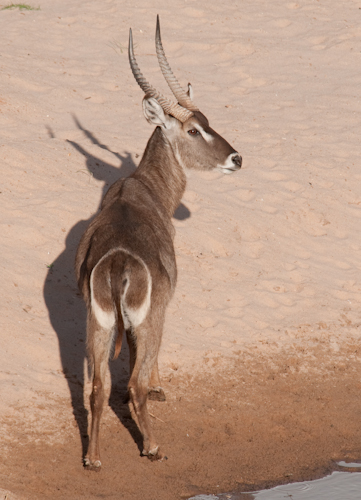 A rather handsome Waterbuck male
A rather handsome Waterbuck male
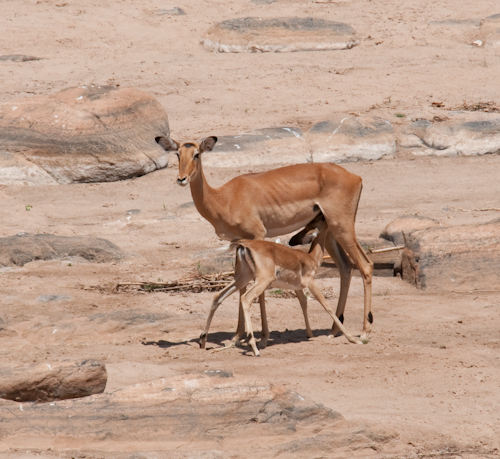 It must have been tough for this Impala mother to keep nursing her fawn all through the drought-induced food shortage
It must have been tough for this Impala mother to keep nursing her fawn all through the drought-induced food shortage
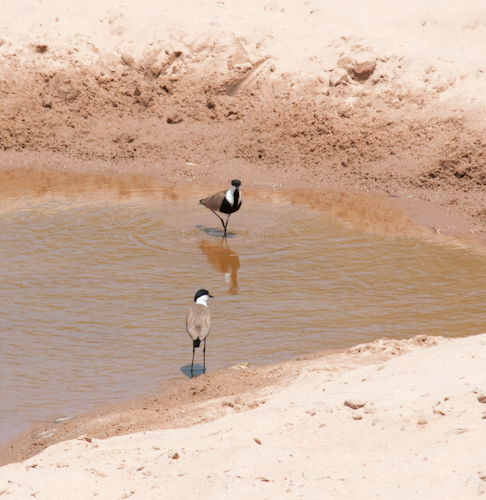 The Spur-winged Plovers, never slow to seize an opportunity, took up residence around the pool we had dug in the riverbed.
The Spur-winged Plovers, never slow to seize an opportunity, took up residence around the pool we had dug in the riverbed.
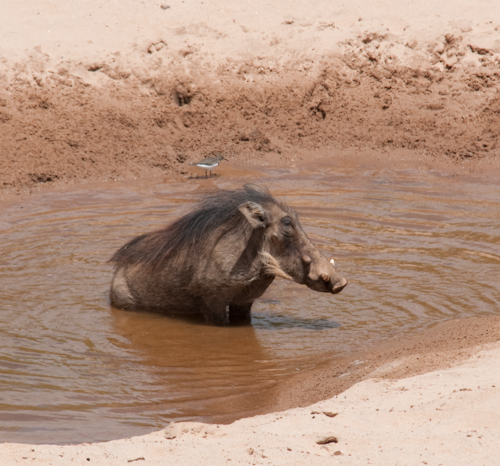 How refreshing! The Warthog knows how it's done. Note the Common Sandpiper behind him too, another grateful resident of the pool.
How refreshing! The Warthog knows how it's done. Note the Common Sandpiper behind him too, another grateful resident of the pool.
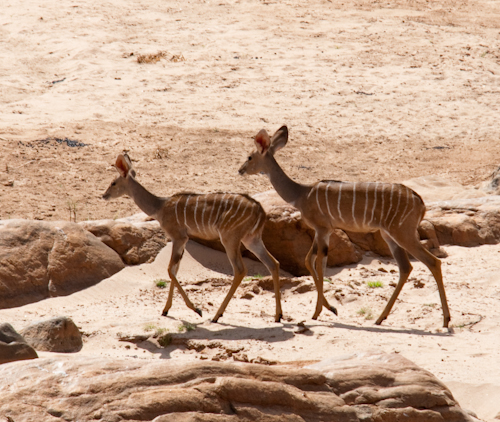 Some scientists say that Kudu never drink, but we watch them drinking every day during the dry season, so we know this is not correct.
Some scientists say that Kudu never drink, but we watch them drinking every day during the dry season, so we know this is not correct.
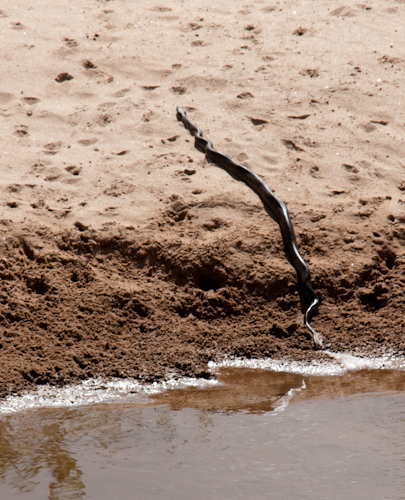 Even a python needs water...
Even a python needs water...
Then, on 5th October, the fireball lilies on our balcony came out in flower – normally a sign that the rain is only 10 days away.
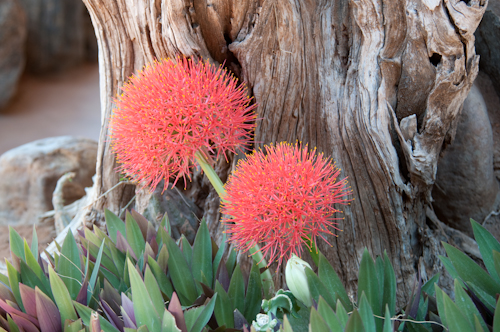
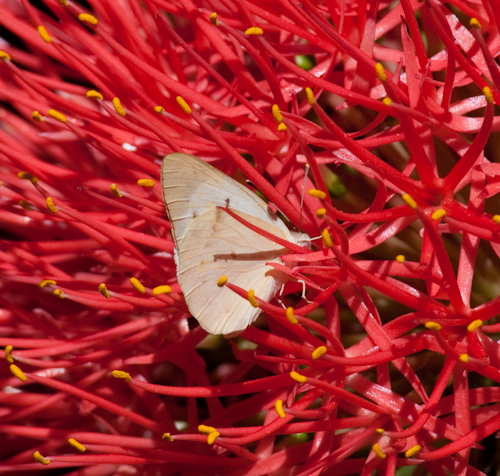 A butterfly makes the most of the flowering fireball.
A butterfly makes the most of the flowering fireball.
Slim, our voracious black-tipped mongoose, still regularly showed up for her daily morsels from the kitchen – never satisfied with just one tidbit either, always wanting more!
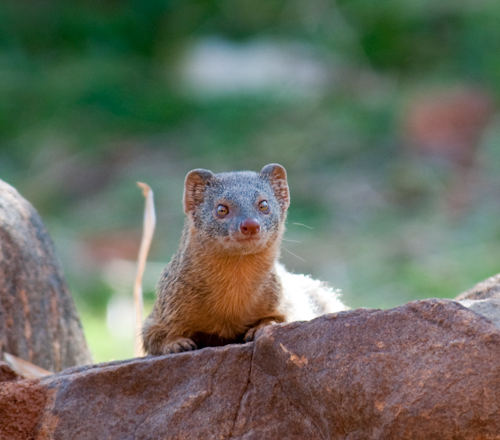
A rather forlorn looking zebra turned up in the river bed, looking for any remaining grass to eat, and the elephants – turning their noses [trunks] up at the pool we had dug – continued to dig their own holes to reach the water down below in the sand.
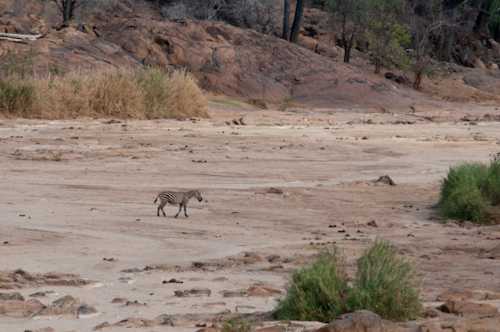
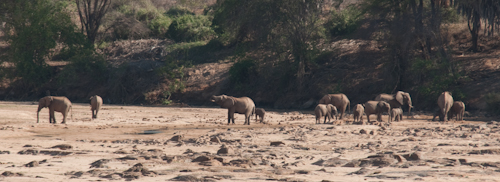
The rather attractive blue basin I had placed out behind the kitchen continued to be popular with the birds, and the dikdiks too, saving them the precarious march across the open sand to the pool in the river bed.
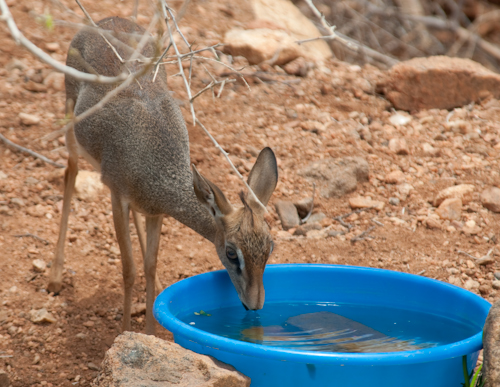
On the 10th October, storm clouds loomed like temptresses over the Yatta, and we held our breath that rain might finally be on its way…but nothing happened:
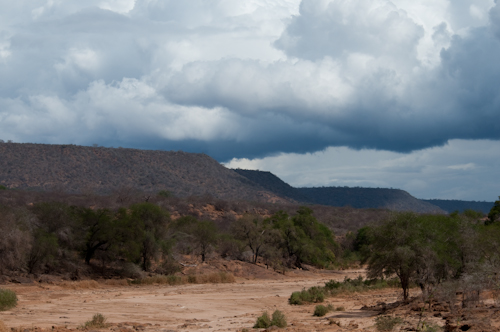
And then – finally – on the 15th, according to the precise prediction of the fireball lilies, the first rain started to fall….not before time for the very thin impala, and all the other animals and plants who had made it this far. (And sadly, many had not made it – in Tsavo West, hundreds of hippos had died by now, not to mention other big game and no doubt lots of less visible small game too.)
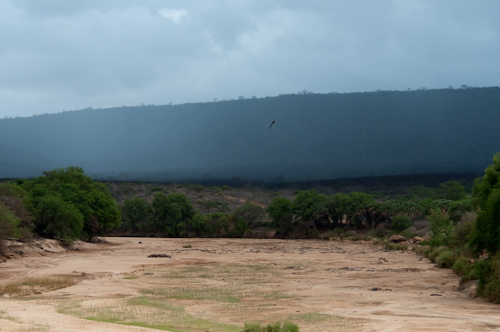 The rain often passes us by, following the Yatta upstream past the house, then it swings around and comes back on us...as seen here, with the first drizzles of rain for months...
The rain often passes us by, following the Yatta upstream past the house, then it swings around and comes back on us...as seen here, with the first drizzles of rain for months...
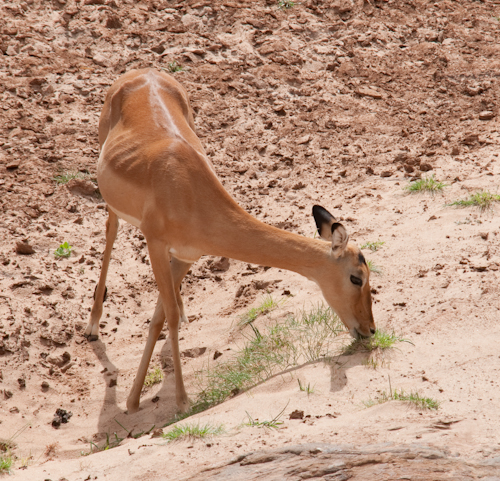 The impala had become achingly thin.
The impala had become achingly thin.
On the 16th October, a tiny trickle of water snaked its way down the riverbed, the first flow to be seen for 41 days:
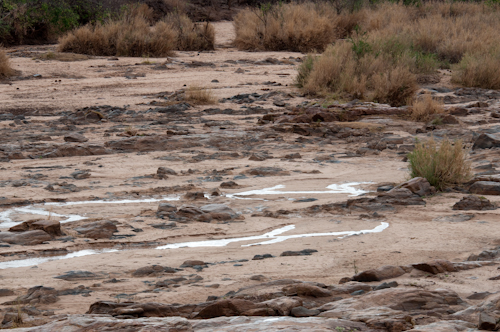
By the 17th, the river was dry again. The rain had not been sufficient to maintain any flow above ground:
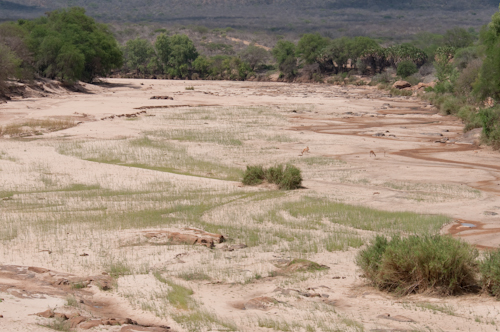
The animals continued to rely on our pool, and on the holes dug by the elephants:
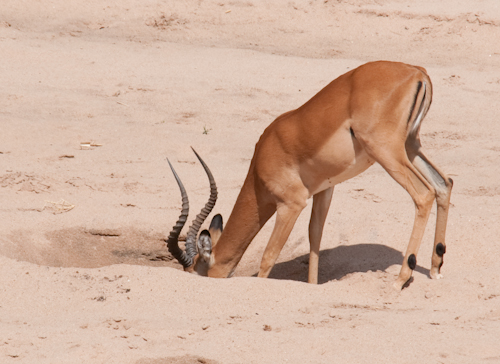
On the 18th, the river finally came down properly, and continued to flow, bypassing our precious pool.
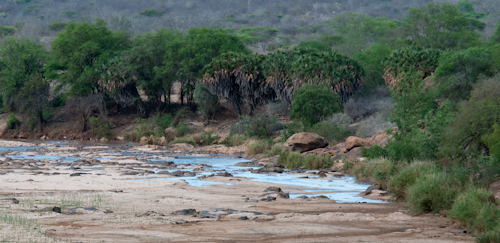

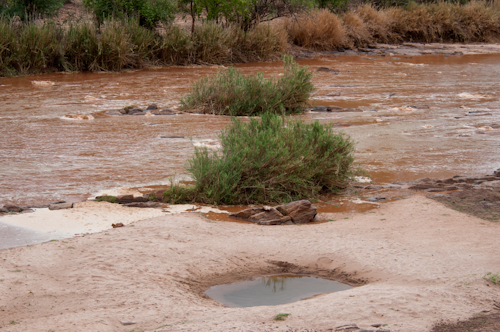 The river flows behind the pool we had dug for the animals during the dry times.
The river flows behind the pool we had dug for the animals during the dry times.
And by the 19th, the river was in full spate…
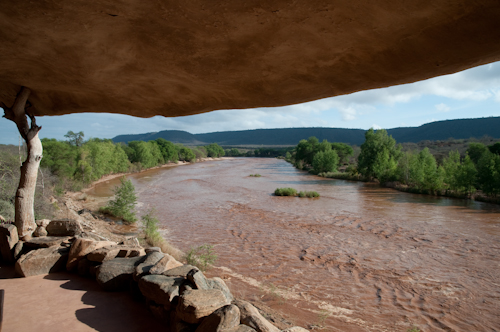
The hippos seemed happy with the new water but there was still no food for them to eat and they were obviously very hungry. They started leaving the river early in the afternoon in search of grazing (normally they would not leave the river to feed until dusk).
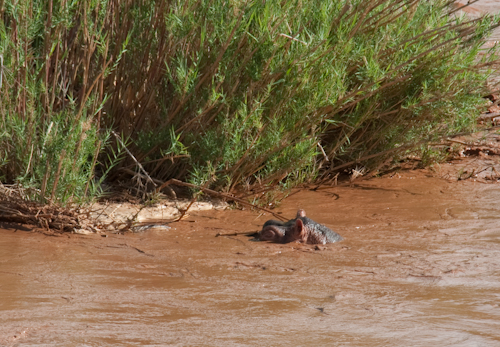 The hippos, happy to be able to submerge themselves in the water again...but without any grass to eat yet, still very hungry:
The hippos, happy to be able to submerge themselves in the water again...but without any grass to eat yet, still very hungry:
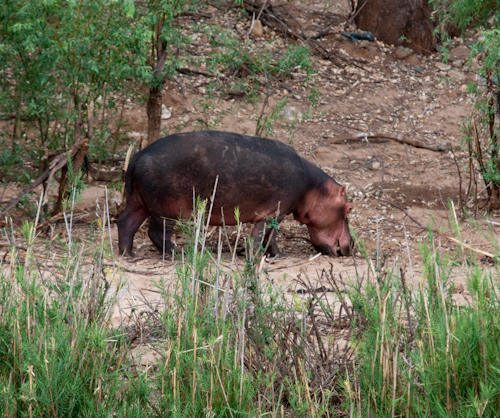
The 20th October saw the return of a migrant Black Stork. These birds, which come all the way from northern Europe and Russia, are highly endangered and it always feels like a privilege that one or two of them choose to come here to Kulafumbi each year:
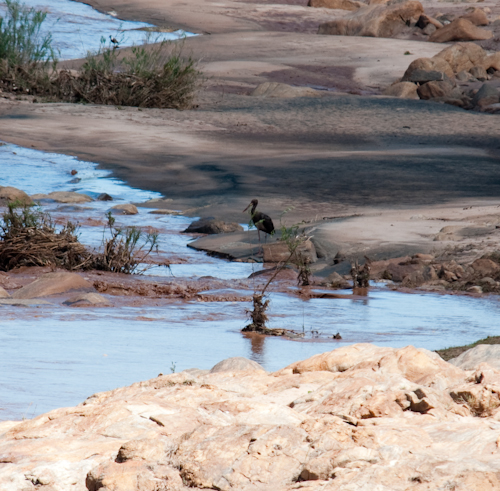
Very soon, life seemed to return to normal on the river. The Grey Heron was back, and the crocodiles were happily basking in the sun again (during the drought, they had hidden themselves away in caves, hollowed out of the river banks). The lovely hill covered with euphorbia just downstream from the house, bathed in evening light, seemed to represent the tranquility of the river and the relief from the drought as the vegetation sprang to life again and food for all the herbivores became plentiful once again.


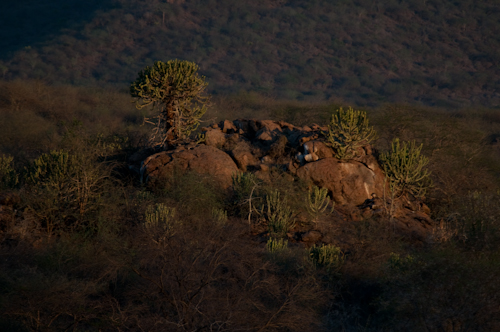
The white lilies on our balcony flowered briefly but beautifully:

The Black-headed Weavers went into a frenzy of nest-building, as they seem to do with every whisper of rain. The yellow-barked acacia tree growing on our balcony provided fresh green leaves to line their nests:
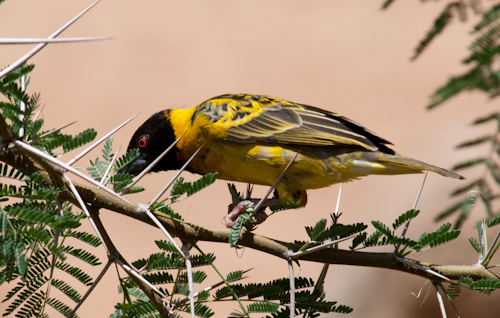
Even our melia tree, which had been stripped bare of any leaves during the drought by the voracious hyraxes, began sprouting new leaves and even started flowering. (Most of our other melia trees – which had been a wedding present to us – had been killed off by the hyraxes, but this one seems to be a survivor):
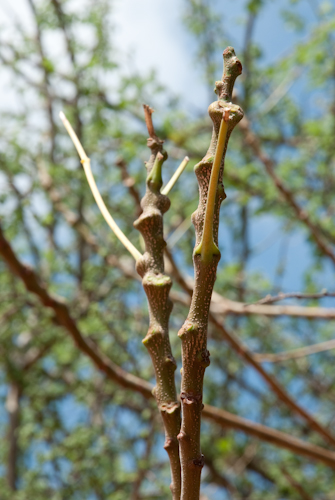 Chewed beyond recognition during the dry season by the hyraxes, desperate for any greenery they could find, our lovely melia tree persevered and produced new leaves and even flowers as the rain began. The wire frame you can see in the picture below is to protect the base of the tree from porcupines who would chew off the bark, given half a chance.
Chewed beyond recognition during the dry season by the hyraxes, desperate for any greenery they could find, our lovely melia tree persevered and produced new leaves and even flowers as the rain began. The wire frame you can see in the picture below is to protect the base of the tree from porcupines who would chew off the bark, given half a chance.
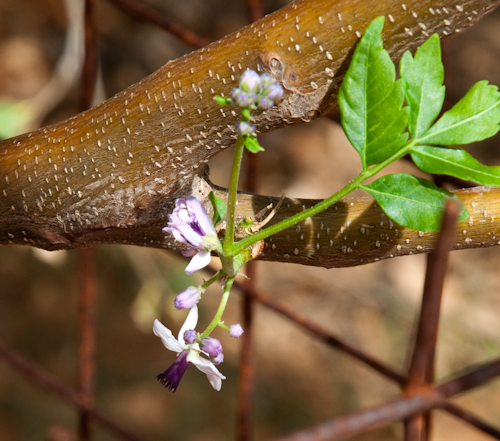
With the rain came the bugs, of course…much to the delight of the genet cats. In the kitchen, our net screens kept out most of the moths and the genets learned that if they jumped onto the top of the open windows, they could reach over and grab the moths off the screens…a fine feast, if you’re agile enough!
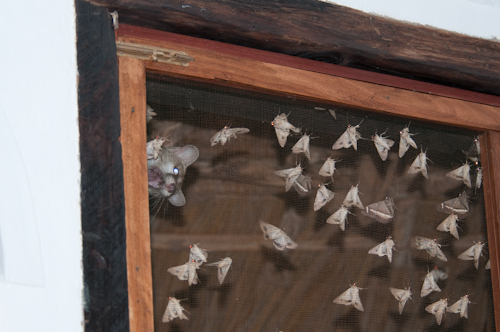 Jean-Genie catching moths from atop of the window (above) and Two-Notch-Charlie enjoying a bug-fest on the balcony (below).
Jean-Genie catching moths from atop of the window (above) and Two-Notch-Charlie enjoying a bug-fest on the balcony (below).
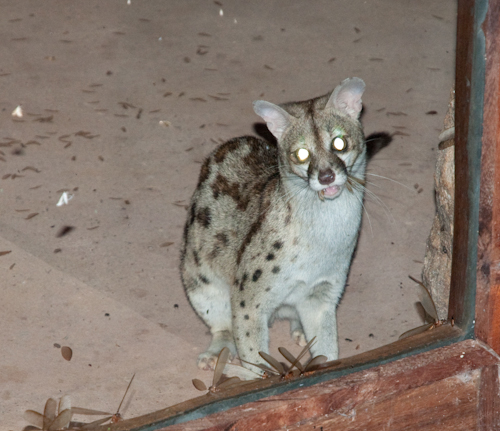
Of all the animals, the genets seem to be the only ones who are not “fair-weather friends” – come rain or shine, they are here every evening, sneaking into the kitchen while I am cooking, hoping for a treat or two. As for our other animal companions, the minute it started to rain, the dikdiks, which had been so friendly when hungry, vanished overnight, as did Slim the black-tipped mongoose, all the banded mongooses and even Hook, the ground squirrel who was always around at lunchtime hoping for a free meal. With the rain, they all returned to their natural wild lives without a thought for us – which is of course exactly how it should be…and we know they’ll be back, come the dry season again.
Whenever I think of the river, I picture it like this (the classic view, I call it), with the river in full flow but not flooding and the glorious white sandbanks out in all their finery, the Yatta majestically rising up behind and the doum palms green and luscious:
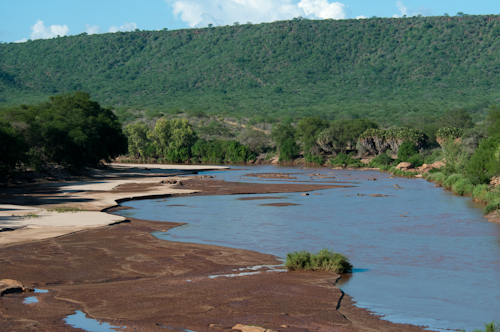
The migrant Amur Falcons which pass through for one day each year came by in their hundreds on the 29th November – difficult as ever to photograph as they swoop by at great speed and oh so elegant…
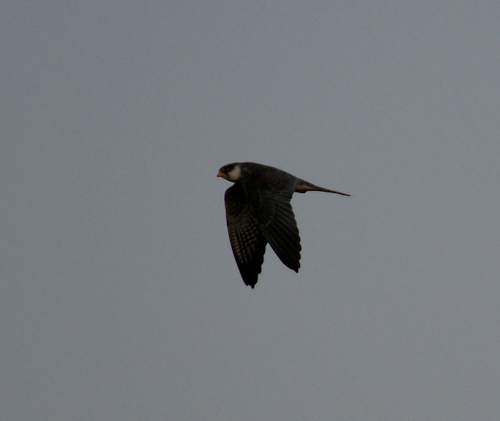
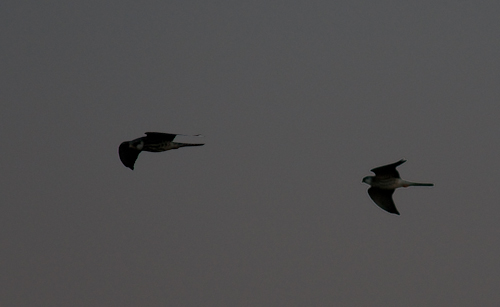
This Great Plated Lizard caused us some amusement on an evening walk down the sandbank. I started to photograph it because I thought it looked rather spectacular in the late evening sun, but then it startled us all by suddenly plunging into the river and slowly but surely – while being dragged relentlessly downstream – crossing the river. It’s amazing that no crocodile snapped it up.
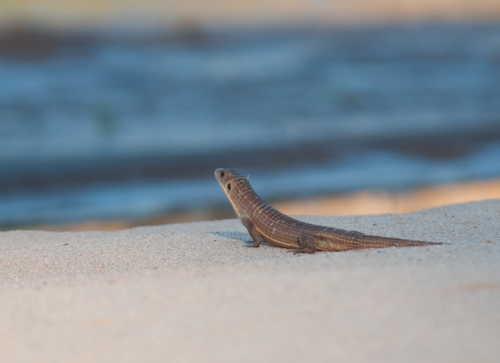
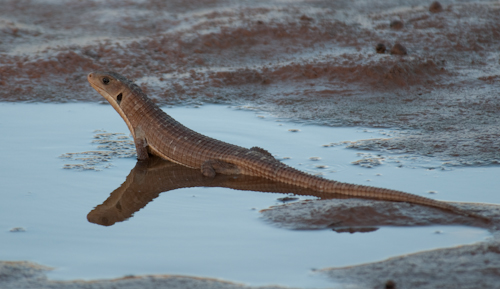
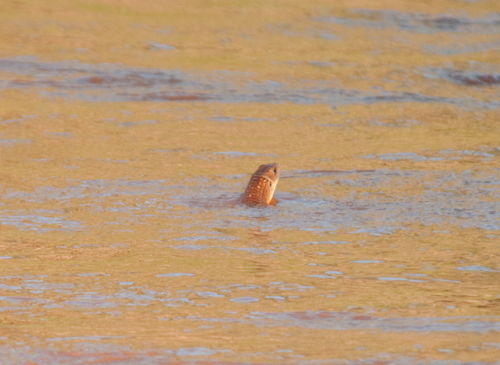
The butterflies came out in force with the rain, and made the most of the time to procreate. Here are just a few of the multitude:
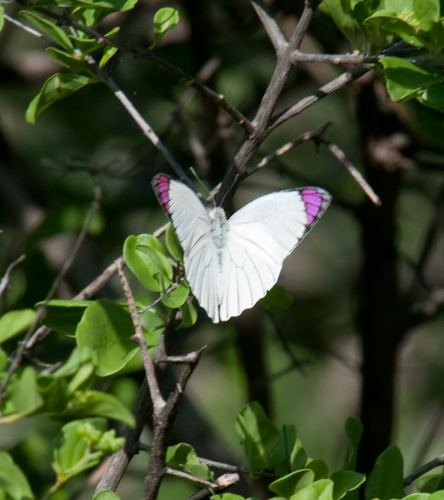
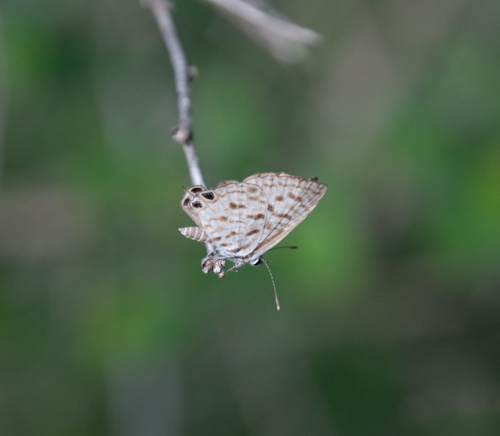
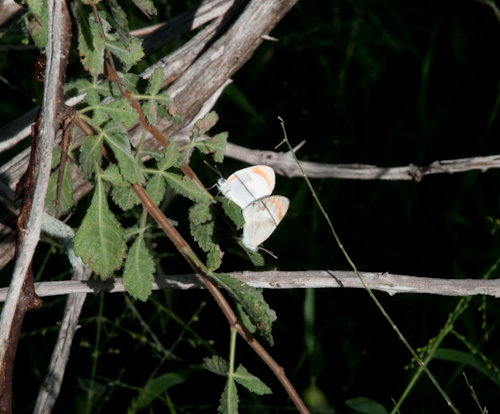
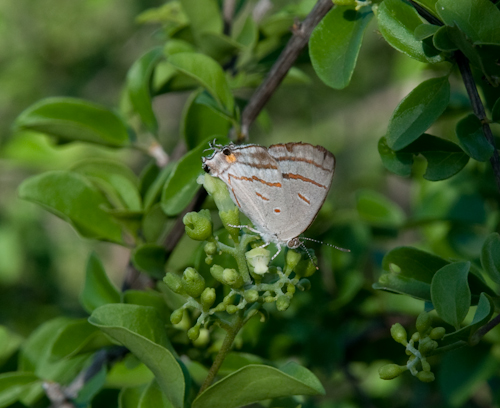
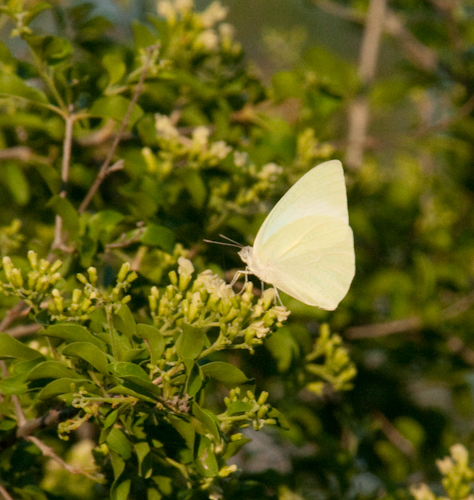
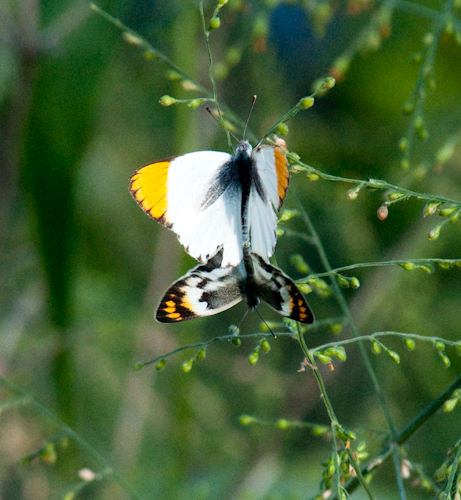
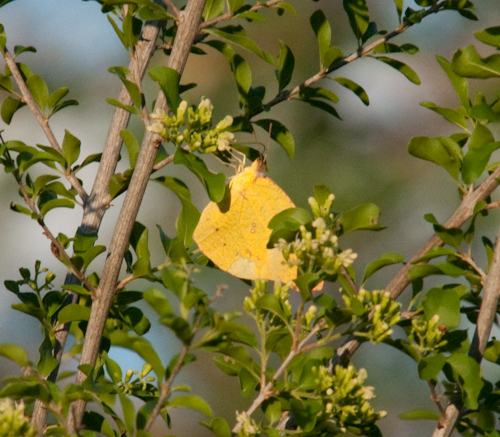
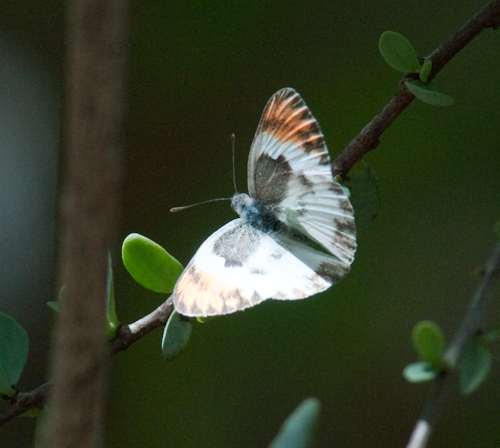
On 1st December, a few of the Bauhinia Taitensis flowers came out in bloom, but nothing compared with the way they normally flower en masse:
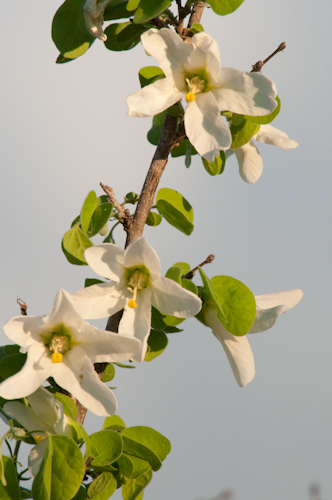
The rain was still around, if somewhat sporadic, casting spectacular rainbows over the landscape…and over the house:
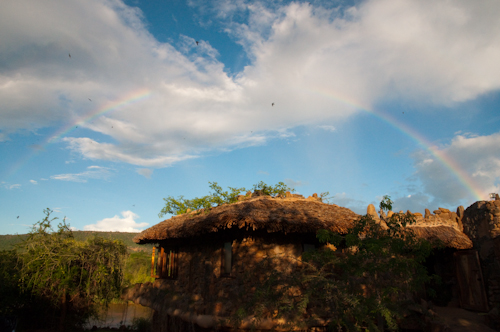
Our resident Goliath Heron had left when the river dried up, as indeed had the Yellow-billed Storks and the Egyptian Geese (and who can blame them? If you have wings, why not fly to greener pastures?) On 5th December, our Goliath Heron was back in residence (but not for long, as it turned out, for soon it was nowhere to be seen again).
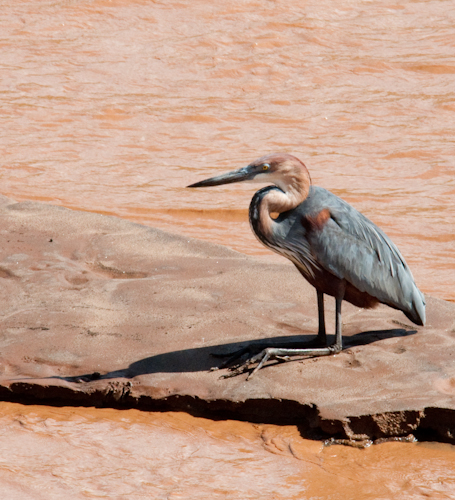
With no sense of decorum, the Skinks started courting on our balcony.
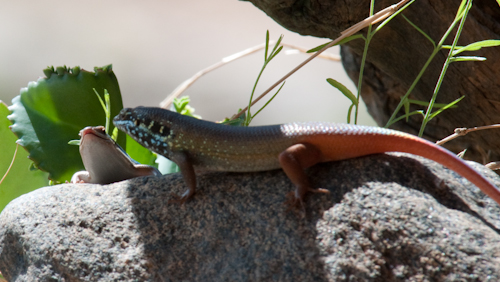
And the Agama Lizard was also in fine fettle, sporting his spectacular colours.

The Spotted Morning Warbler, that most proficient of songsters and perfect imitator of other bird calls, started building its little mud-cup nest under the eaves of our store.
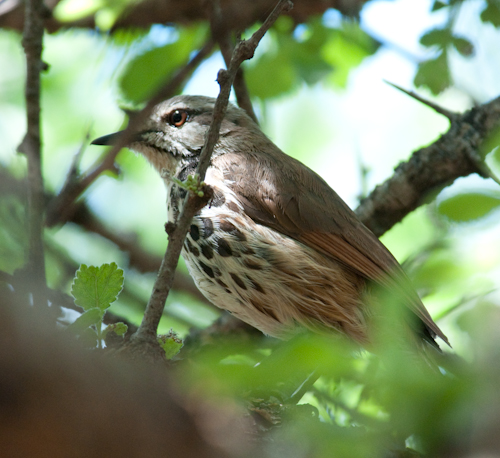
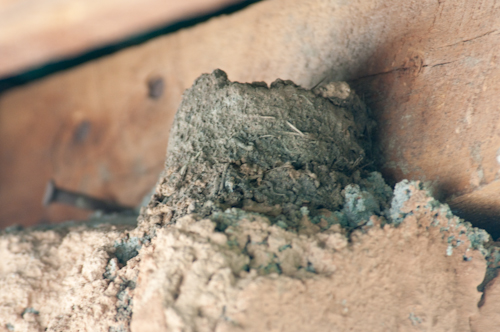
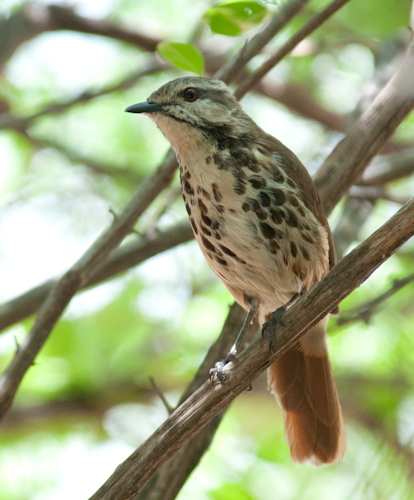
It continued to be a strange season for the flowers, which normally would be blooming in great profusion with the rain. As already mentioned, the Bauhinia had been sparse and sporadic, many of the other flowers failed to show at all and only the Erythrochlamys Spectabilis showed any real enthusiasm for blossoming:
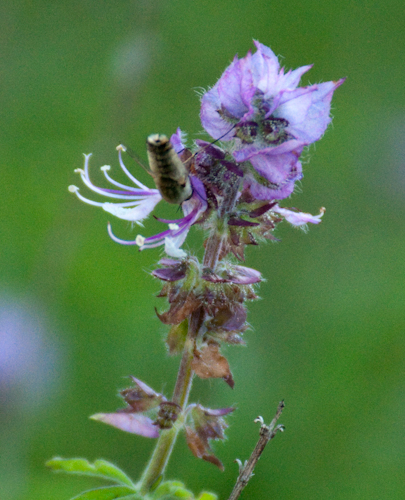
A different type of gecko turned up in the guest room downstairs. I think, judging from the constriction at the base of the tails, it’s a Prince Ruspoli’s Gecko (hemidactylus ruspolii), also known as the Farm Leaf-toed Gecko. It’s very uncommon here, normally being found further north in the desert regions of northern Kenya and Somalia, but a few specimens have been recorded in Tsavo, and I think this is one of them.
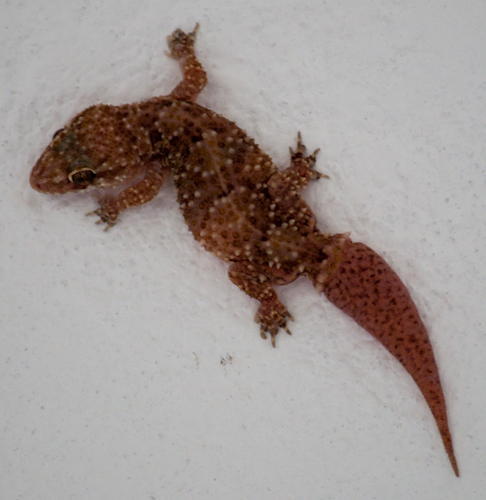
The Hippo Lawn below the house grew thick with star-grass. The hippos quickly made in-roads into it by night, although by day they were nowhere to be seen, having deserted their regular residence in the deep river pool at Hippo Bend.
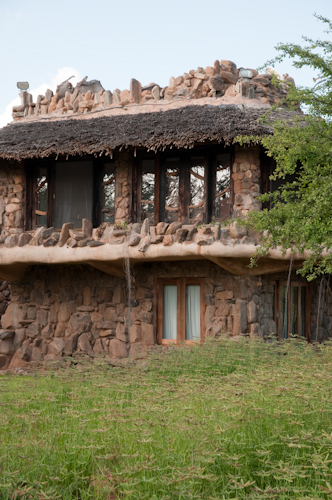
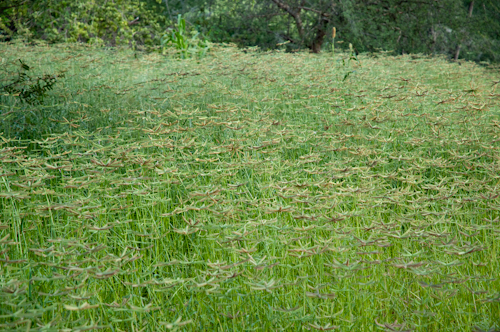
This huge caterpillar (probably 5cm long and 75mm wide) had the most astonishing "false eyes" to confuse predators…I saw it wending its way along the road by the house. It caught my eye because it kept jumping and throwing itself over onto its back, and I wondered what on earth it was doing. Taking a closer look, I could see that a fly kept landing on it and was obviously bothering it immensely. Every time the fly landed on the caterpillar, it threw itself over in an attempt to dislodge the fly. At risk of losing a lot of image quality, I have enlarged my photos so you can see some of this funny scenario being played out:

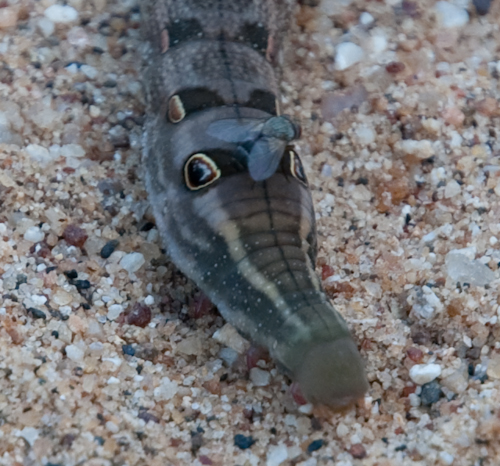
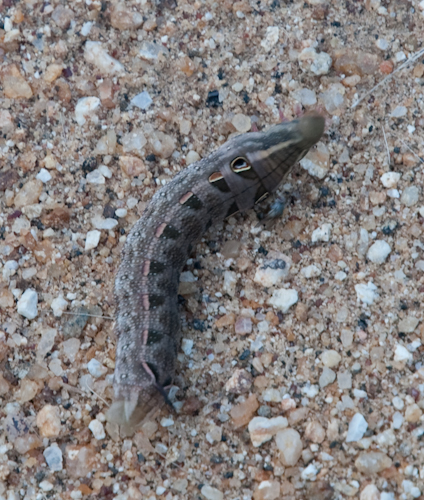
This fat Monitor Lizard was basking on the sandbank like a crocodile:
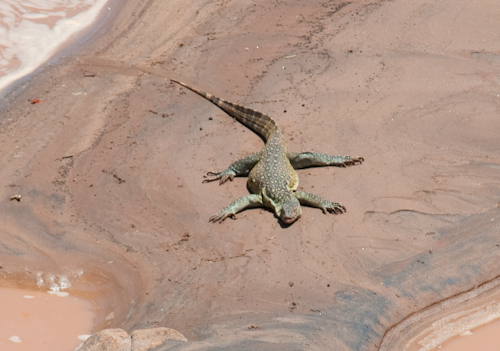
In mid-December, the Quelea started coming to drink on the river. These small, seed-eating weaver birds mass in their millions at certain times of year and when they fly, twisting and turning in perfect unison and banking in the sun, their fluid movement as a flock is reminiscent of a shoal of fish flashing by in the ocean.
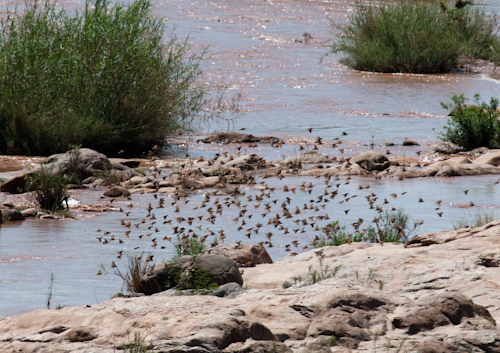
Bringing you more up-to-date now, the White Browed Sparrow Weavers were busy building their nests on 22nd February.
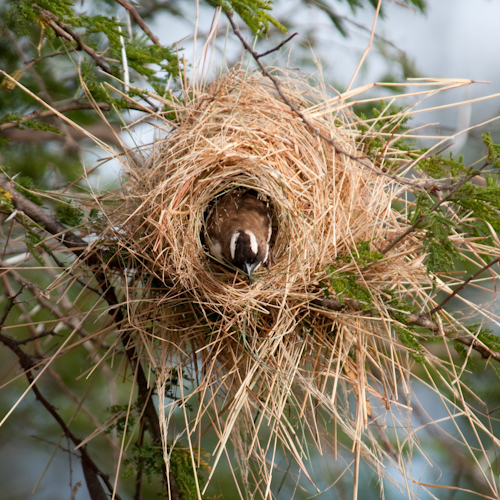
Every time the river comes up and then subsides, it leaves a brand new formation of sandbanks along its edge. This time, the sand bank at Hippo Bend was the widest and flattest we had ever seen it – it was quite fabulous but you’ll have to take my word for that, because I only had my long lens with me when walking there, so could never capture the full extent of the beach in one photograph. Where it dropped off at the waterline, the edge was sharp and dramatic:
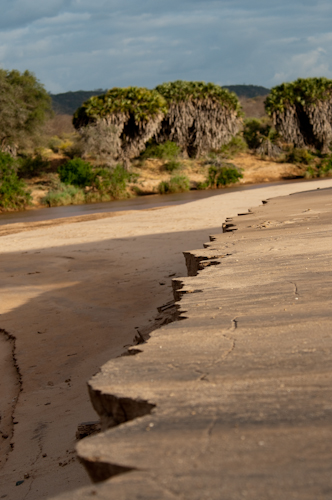
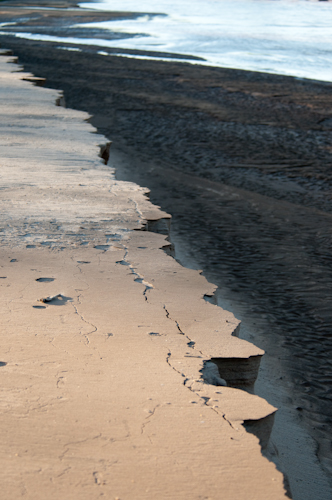
The Acacia Tortilis started flowering, attracting a host of insects and adorning the bushland with their pretty creamy white pom-pom flowers.
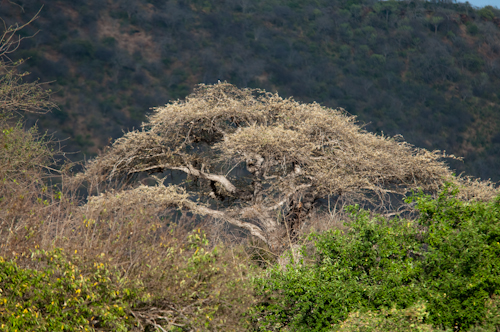
By the last week of February, having had no rain for several weeks, the star-grass was drying out fast, turning golden and brittle:
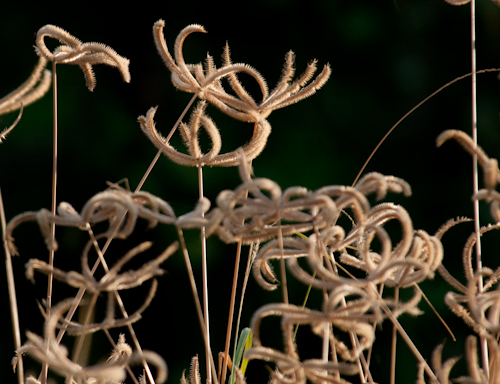
On the 24th February, suddenly our Egyptian Goose pair and our lonesome resident Yellow-billed Stork returned to their usual spot below the house. (I like to think they are the same birds which return to this very spot each year).
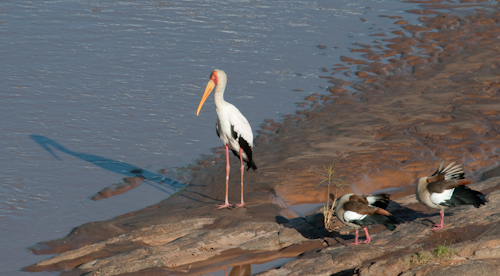
There’s not much courting going on between the geese though, which is strange. Normally the rain would have triggered their mating. The same with the Spur-winged Plovers, which normally nest at the slightest provocation – this year, they have not nested. It seems it’s an odd year for flowers and birds alike.
The migrant waders are on the river again: all the different sandpipers, the little Stint, the White-fronted Plover, not to mention the resident Three-banded Plovers:
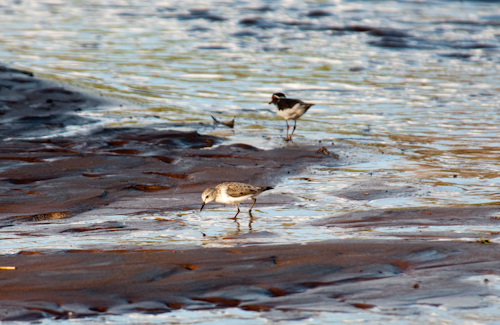 A Little Stint (with Three-banded Plover behind), above, and a Common Sandpiper, below.
A Little Stint (with Three-banded Plover behind), above, and a Common Sandpiper, below.
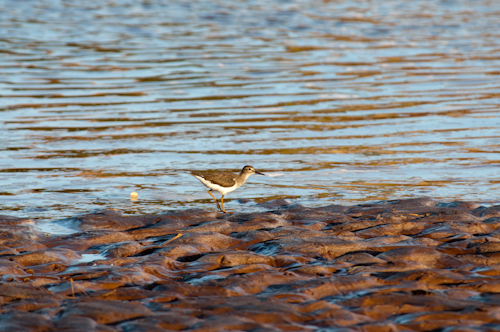
 A Three-banded Plover (above) and a Wood Sandpiper (below.)
A Three-banded Plover (above) and a Wood Sandpiper (below.)
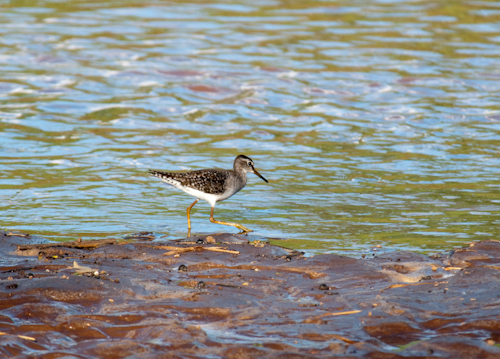
These Mole Rats have defied logic by digging their tunnels in the sand on the river’s edge – how do they manage it without their tunnels collapsing? Ugly, blind, hairless underground creatures they may be, but clever too it would appear…
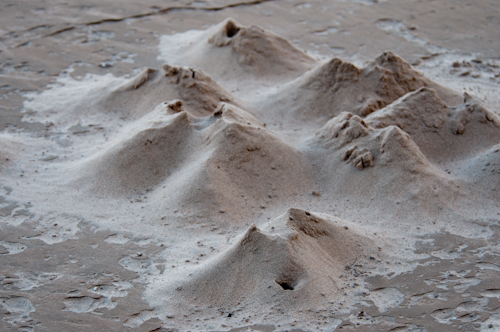
Nature is relentless, isn’t it? A thin layer of soil in between the sand on this bank has allowed seeds to germinate and a striking layer of green vegetation to bloom:
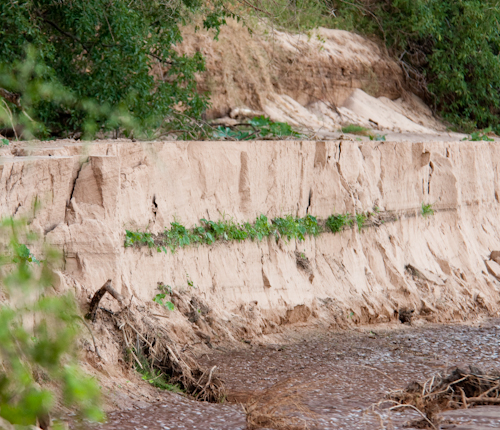
Our geese, in perfect symmetry on a grey morning in late February:
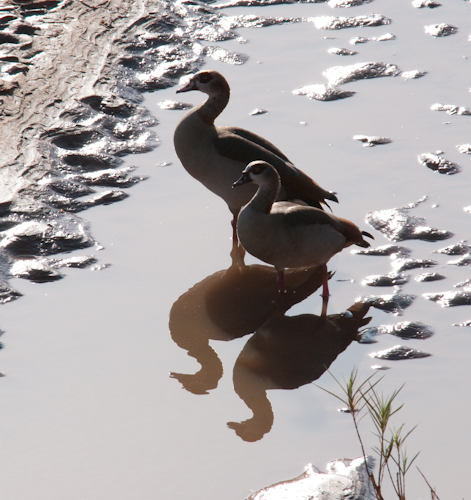
The red aloe on our balcony started flowering for the first time, which is rather lovely.
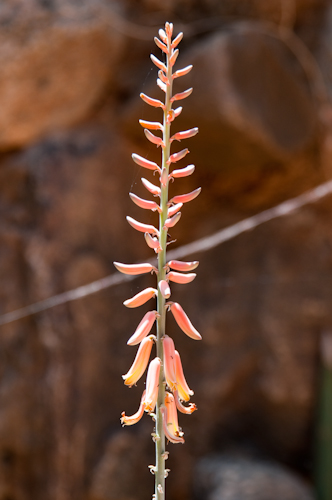
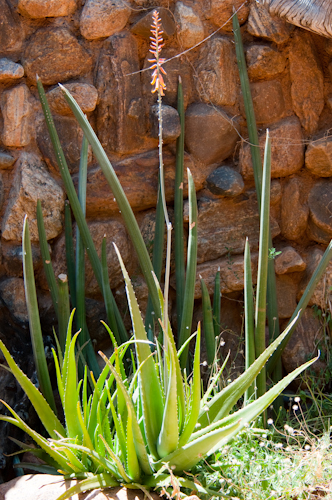
In the last days of February, the river was still as picture-perfect as ever:
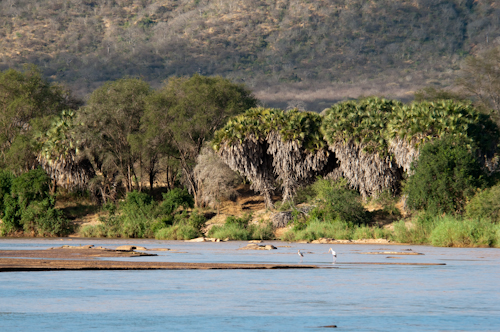
The geese were enjoying the new grass sprouting up on the river banks.
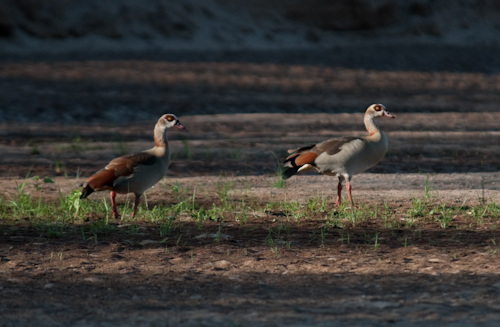
The Laughing Doves completed the tranquil picture of a perfect Tsavo evening:
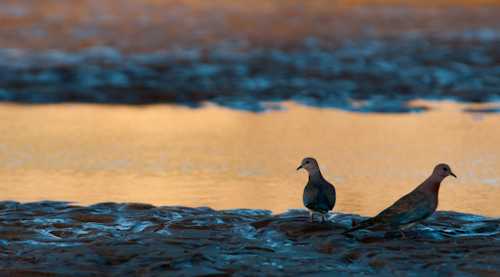
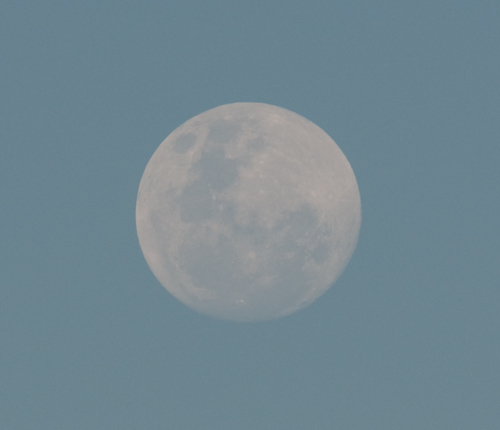 The day before full moon.
The day before full moon.
The full moon on the 28th February brought back the rain with a vengeance. Storm after storm started to pound the bushland, and the river came roaring down in full flood. This is completely unseasonal. First we had 18 months without rain, then a longer than normal rainy season (soaking us over Christmas), followed by just a few weeks of dry times, and now this…there is nothing predictable about the weather any more.
These photos were taken on 8th March, with both the Athi and Mtito Rivers raging in flood:
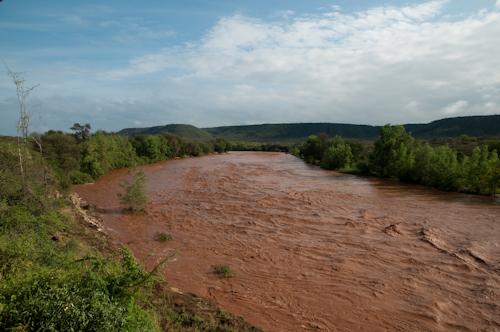 The Athi River, upstream (above) and downstream from the house (below.)
The Athi River, upstream (above) and downstream from the house (below.)
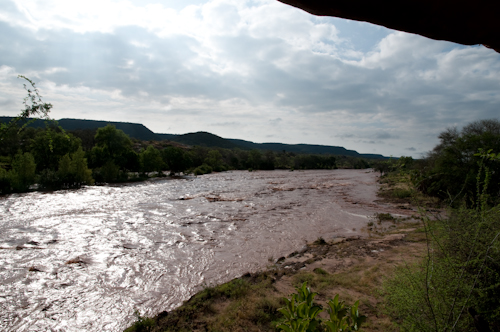
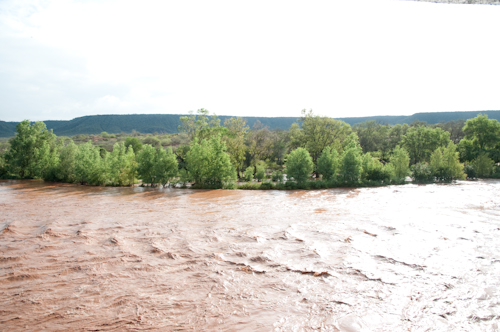 Opposite the house (above and below), many trees were flooded, and even our lovely yellow fig tree was engulfed by water. Happily, when the water retreated, the big trees had all survived.
Opposite the house (above and below), many trees were flooded, and even our lovely yellow fig tree was engulfed by water. Happily, when the water retreated, the big trees had all survived.

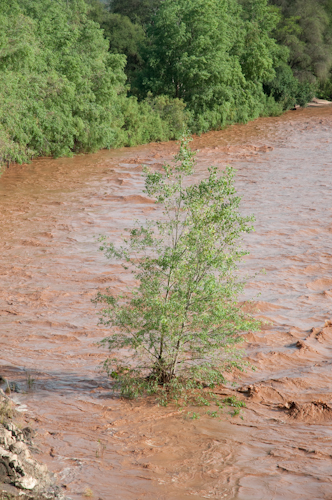 A small Tana River Poplar just below the house soon found itself drowning (above) but it too withstood the flood waters. Meanwhile the road crossing into the park became instantly impassable as the Mtito River also started flooding (below).
A small Tana River Poplar just below the house soon found itself drowning (above) but it too withstood the flood waters. Meanwhile the road crossing into the park became instantly impassable as the Mtito River also started flooding (below).
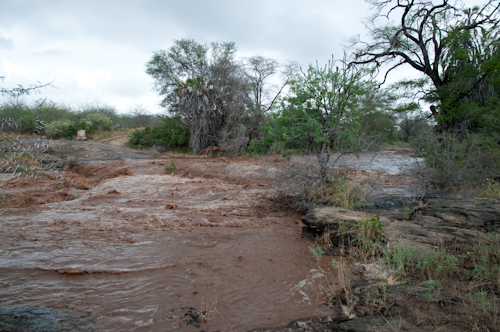
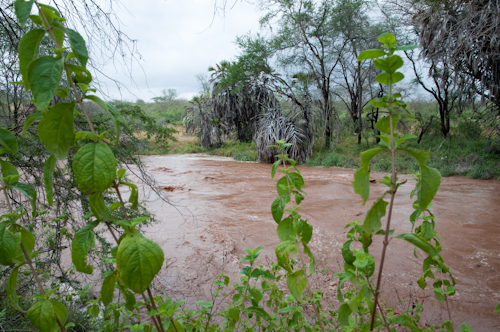 Above and below our "dam" (really a weir) on the Mtito River, the waters were also raging.
Above and below our "dam" (really a weir) on the Mtito River, the waters were also raging.
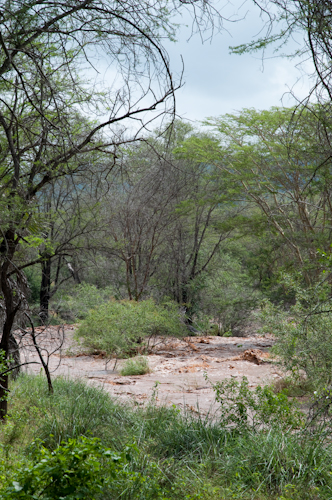
This time, the flowers seem to be responding, with a swathe of Bauhinia coming out in blossom:

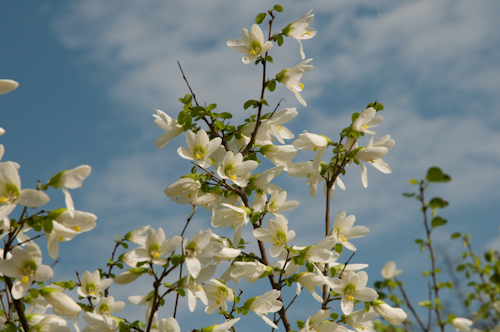
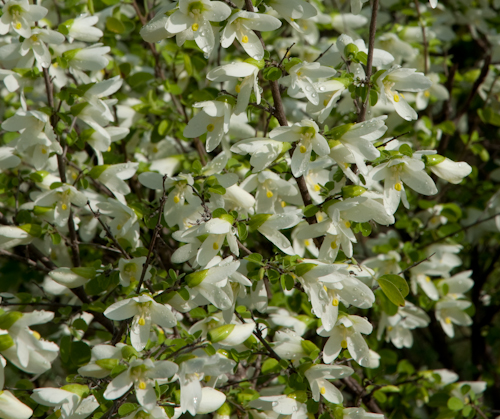
The Commelina have also started poking out their beautiful blue heads:
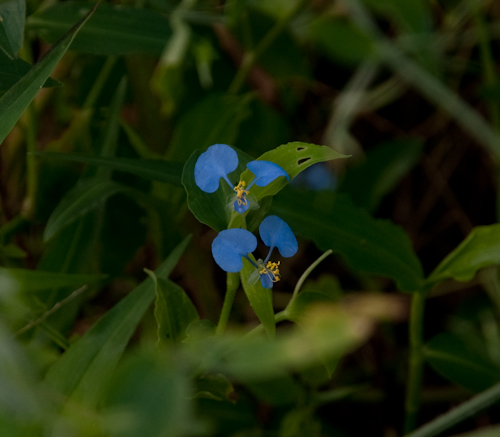
This little pink flower was also particularly striking:
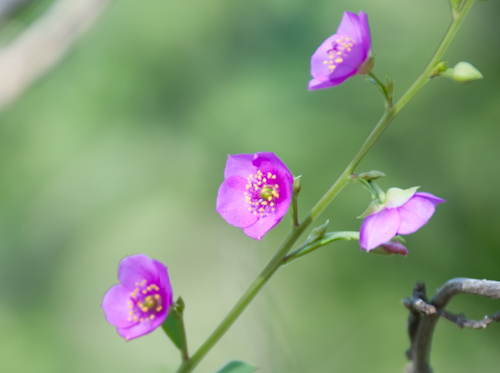
Some of the Commiphora trees are heavy with berry, and the Terminalia Robertii are also sporting a fine crop of deep red seed pods:
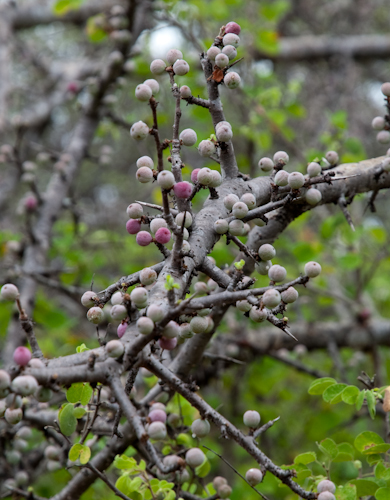
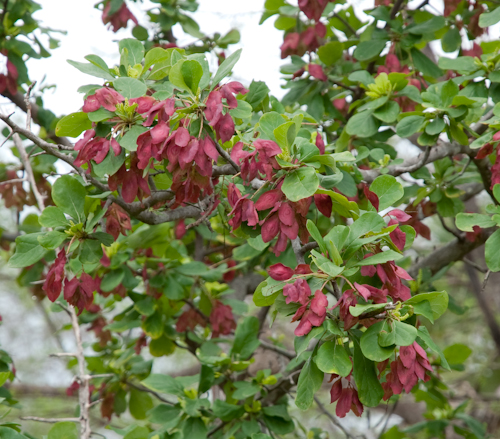
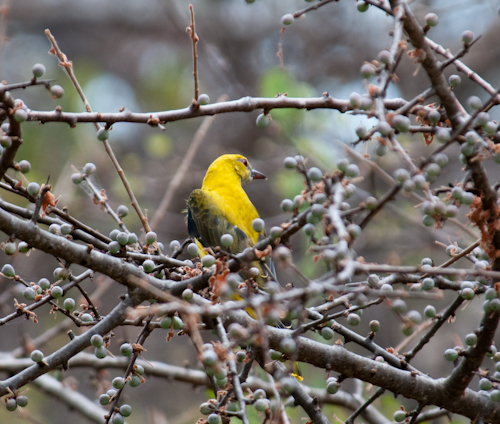
A Eurasian Golden Oriole turned up in the Commiphora thicket by the kitchen (above), and a pair of Wire-tailed Swallows are busily building on our balcony:
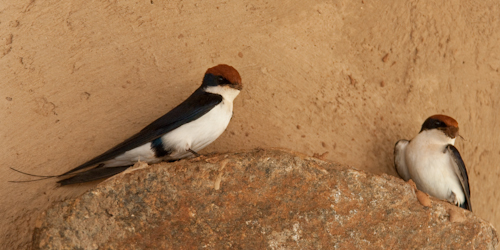
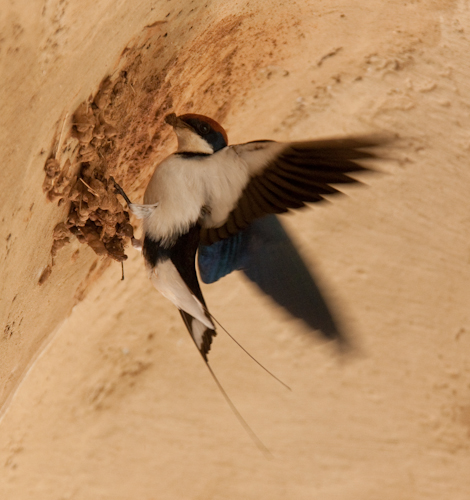
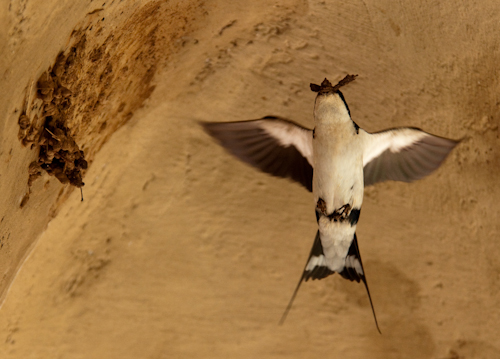
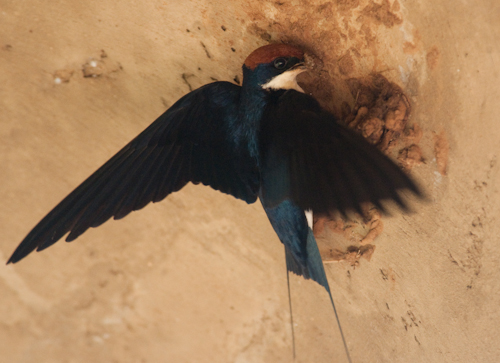
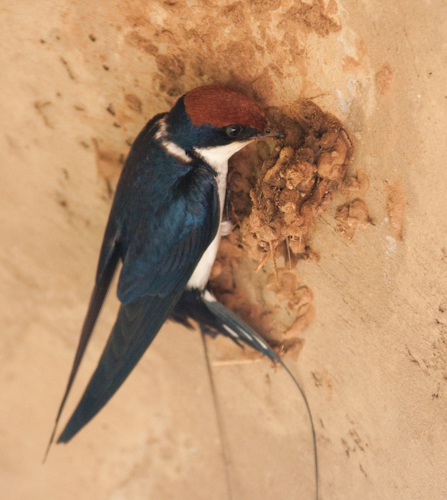
The Sparrows also started building a nest in the hole in our wooden balcony post (popping in one "door" and out the other) but sadly for them, the genets soon found the nest hole and thwarted any efforts at building there.
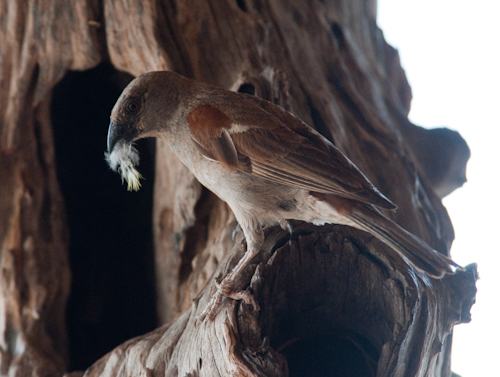
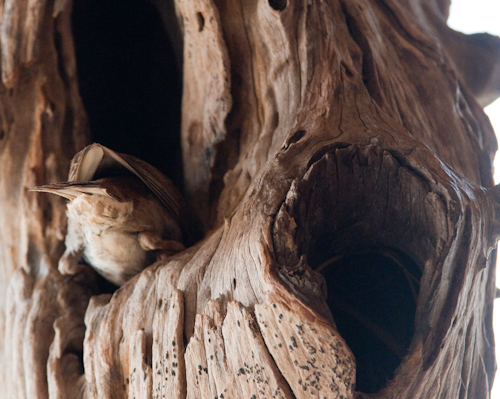
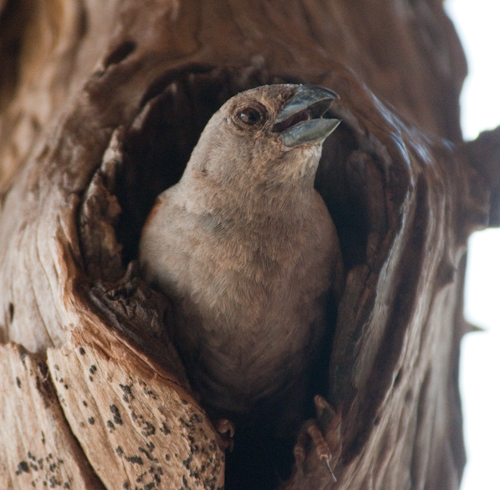
This bee is also nesting in its own tiny hole in the wooden post.
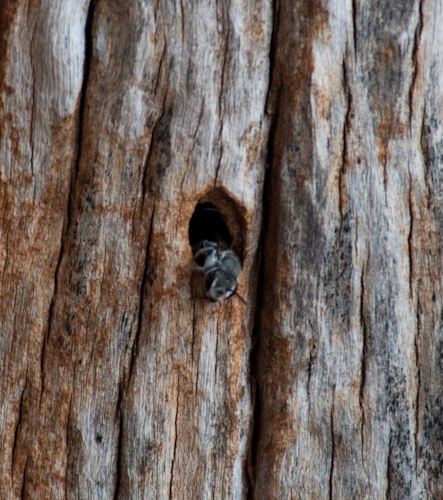
The European Rollers have been around in force for a few weeks, flashing iridescent blue against the storm skies, competing only with the rainbows for brilliance.
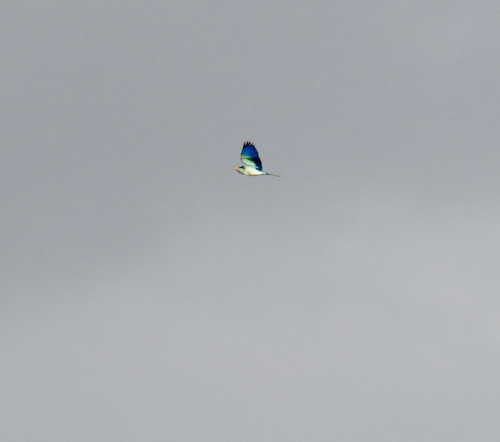
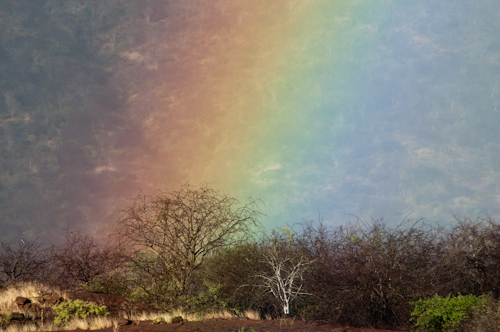
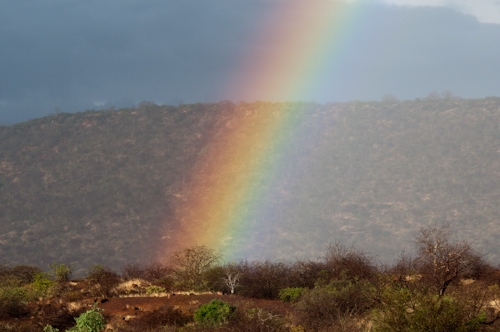
Of course, following the rain as ever, both the Red-chested and the Diederiks Cuckoos are back too. And at least the hippos are fat and happy again:
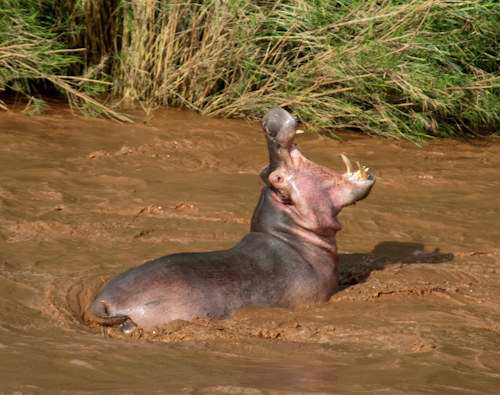
The Baobab trees around the house have survived the fluctuations in the weather, and with the rain are sprouting new green leaves:
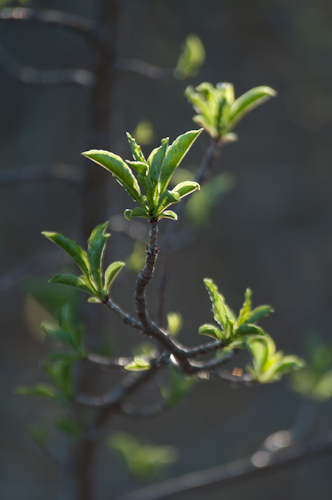
Meanwhile, the storm clouds continue to gather and fall in great torrents of rain, and we wonder whether this might be the beginning of another El Nino, as we saw back in 1997-98 when it didn’t stop raining for 9 months, and the country turned into a quagmire…
 11 Comments |
11 Comments |  Tanya | in
Tanya | in  "Our" Egyptian Goose Family,
"Our" Egyptian Goose Family,  Animals In House,
Animals In House,  Antelope (general),
Antelope (general),  Balcony Garden/Flowerbeds,
Balcony Garden/Flowerbeds,  Big Game (general),
Big Game (general),  Birds (general),
Birds (general),  Birds (migrants),
Birds (migrants),  Birds (nesting),
Birds (nesting),  Crocodiles,
Crocodiles,  Dik Diks,
Dik Diks,  Elephants,
Elephants,  Flowers,
Flowers,  Full Moon,
Full Moon,  Garden Trees & Plants,
Garden Trees & Plants,  Genet Cat,
Genet Cat,  Hippo,
Hippo,  Hippo Lawn,
Hippo Lawn,  Impala,
Impala,  Insects,
Insects,  Kudu,
Kudu,  Lizards,
Lizards,  Mongooses,
Mongooses,  Plants (general),
Plants (general),  Rain,
Rain,  River Level High,
River Level High,  River Level Low,
River Level Low,  Slim, the Black-Tipped Mongoose,
Slim, the Black-Tipped Mongoose,  Small Animals (general),
Small Animals (general),  Snakes,
Snakes,  Squirrels,
Squirrels,  Trees,
Trees,  Warthogs,
Warthogs,  Waterbuck
Waterbuck 
